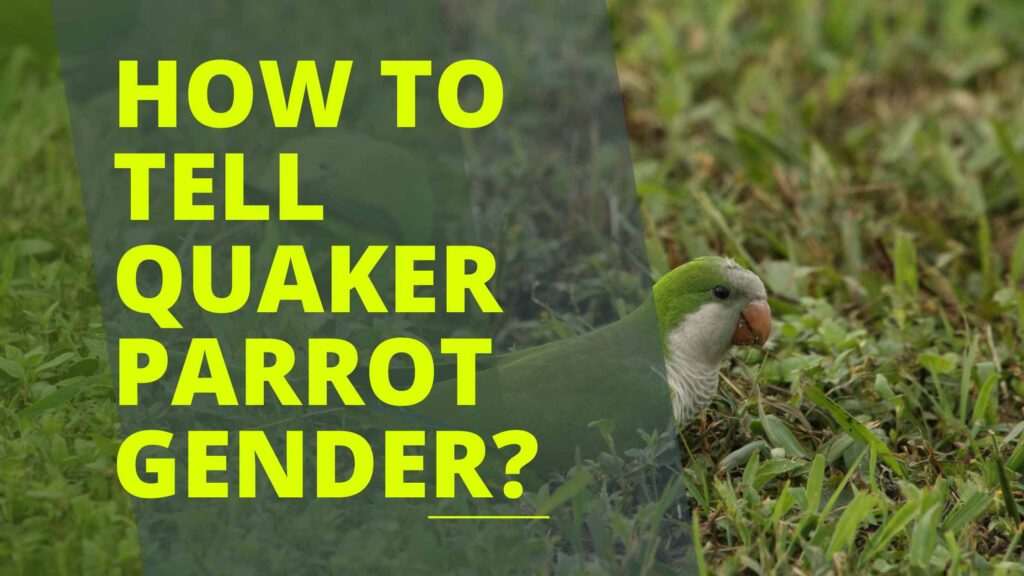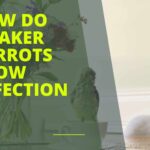Determining the gender of a Quaker parrot can be challenging since they are monomorphic. DNA testing or surgical sexing are the most accurate methods for identifying their sex.
Understanding the gender of your Quaker parrot is essential for various reasons, from naming to breeding or addressing specific behavioral traits. These vibrant, medium-sized parrots, also known as Monk Parakeets, may not exhibit visual differences between males and females, making it tricky for parrot enthusiasts to distinguish their gender.
How to Tell Quaker Parrot Gender? For accurate identification, owners often resort to methods beyond physical observation, seeking scientific intervention to ensure the certainty of their bird’s gender. Engaging with your pet and getting to know the nuances of its personality become a delightful experience once the gender mystery is resolved, paving the way for a stronger human-parrot bond.
Sexual Dimorphism In Quaker Parrots
Quaker Parrots, famous for their social nature, also present subtle tells in their appearance that can help determine their gender. Recognizing these traits means looking closely at their physical features and color patterns. With careful observation, you can become adept at telling male from female Quakers.
Physical Differences
Size and shape offer clues about a Quaker Parrot’s gender. Typically, male Quakers are slightly larger with a broader head and a more pronounced beak. In contrast, female Quakers tend to have a slender build with a narrower head. But always remember, these differences can be subtle and vary among individuals.
Color Variation Patterns
Color patterns can reveal a Quaker’s sex, though not as reliably as physical size and shape. Many believe that males possess more vibrant hues, while females display softer tones. Yet, coloration can be influenced by factors like diet and lighting, making this method less definitive than observing physical differences.
The Challenge Of Determining Gender
Finding out if a Quaker parrot is a boy or girl can be puzzling. Unlike many birds, Quaker parrots don’t flaunt their gender. This means owners and breeders need to look closer. Understanding gender helps in choosing names, breeding, and health care. Let’s dive into the subtle world of Quaker parrothttps://avianwhispers.com/how-smart-are-quaker-parrots/ genders.
Lack Of Obvious Sexual Markers
Many bird species have clear traits that shout “male” or “female”. Think bright feathers or special dances. Not Quaker parrots. Both boys and girls look identical. Their green feathers and charming personalities don’t give away their secret. It’s like they wear a cloak hiding their gender from the world.
So, how can we tell them apart? Expert eyes sometimes spot small differences in size or feather shape. Still, these are not foolproof signs. DNA testing or surgical sexing are the go-to methods for a definite answer. These should be done by vets or professionals, to ensure the safety of the feathered pals.
Behavioral Similarities Between Genders
The challenge doesn’t end with their looks. Boys and girls act almost the same. They both can mimic human speech, show affection, and throw tantrums. They’re sociable birds, loving to chat and play regardless of their gender. It’s what makes them such beloved pets. Their personalities shine bright, boy or girl.
- Both males and females bond deeply with their human families.
- They display high intelligence and a knack for learning tricks and words.
- They need attention and social interaction daily.
Subtle behavioral clues might hint at gender. For example, males might be slightly more vocal or territorial. Females may show nesting behaviors when they reach maturity. Remember, these behaviors vary with individual birds.
Dna Testing As A Reliable Method
Identifying a Quaker parrot’s gender can be tricky just by appearances. DNA testing emerges as a reliable method, offering a high-accuracy solution. With a DNA test, parrot owners can determine the sex of their feathered friend without guesswork.
Process Of Avian Dna Sexing
Bird enthusiasts find avian DNA sexing straightforward. The process involves collecting your Quaker parrot’s DNA sample with ease:
- Gently collect a few feathers or a blood sample.
- Send the sample to a specialized laboratory.
- Wait for analysis and results.
Results arrive quickly, ensuring accurate sex identification for Quaker parrots.
Pros And Cons Of Dna Testing
| Pros | Cons |
|---|---|
|
|
While the pros outweigh the cons, owners should weigh both before deciding on DNA testing for gender determination.

Credit: www.reddit.com
Surgical Sexing Procedures
Determining the gender of a Quaker parrot can be quite the challenge. Unlike other creatures, these birds lack distinct sexual dimorphism. This means males and females look almost identical. For breeders or pet owners eager to know the gender of their feathered friends, surgical sexing procedures serve as a reliable method. These procedures provide a definitive answer but come with certain considerations.
Endoscopy And Its Accuracy
Endoscopy is a popular surgical method to tell the gender of Quaker parrots. A vet uses a tiny camera inserted into the bird’s body. This camera helps the vet see the internal sex organs. It shows ovaries in females and testes in males.
Accuracy rates for endoscopic sexing are very high. This method rarely gives incorrect results. It is swift and precise. Endoscopy gives answers within minutes and allows breeders to plan accordingly.
Risks And Ethics Of Surgical Sexing
Although endoscopy is accurate, it’s vital to understand the associated risks. All surgeries carry a level of risk. These include:
- Anesthetic complications
- Infections
- Tissue damage
Vets must follow strict protocols to minimize these risks. The owner’s consent is crucial, considering the invasive nature of the procedure.
Another aspect to consider is the ethics of surgical sexing. The procedure’s necessity is often debated. Some people question if it’s ethical for non-breeding purposes. Thus, many choose to conduct this procedure only when it’s absolutely necessary.
Behavioral Clues To Identify Gender
When owning a Quaker parrot, knowing if your feathered friend is male or female can be puzzling. While DNA testing provides the most accurate result, specific behaviors can offer clues. Observe your Quaker’s behavior closely; it might tell you more about their gender than you think.
Mating And Nesting Behaviors
Quaker parrots show unique behaviors during mating season which can indicate their gender.
- Males often perform strut-like dances to charm the females.
- Females typically display interest in soft materials for nesting purposes.
Spot a Quaker collecting twigs or shredding paper? It might be a female getting ready to nest.
Aggression And Territoriality
Gender can influence a parrot’s temperament. Male Quakers may act more dominant or show aggression to defend their space. In contrast, females might be less inclined to territorial displays.
| Behavior | Male Quaker | Female Quaker |
|---|---|---|
| Guarding Cage | Common | Less Common |
| Reacting to Mirrors | Marked Aggression | Mild Interest |
Watch for a Quaker that consistently guards its cage or reacts strongly to its reflection; this could be a male marking his territory.
Monomorphic Birds: A Closer Look
Quaker parrots, charming and sociable, keep many guessing about their gender. Unlike other species, these birds do not flaunt their gender through color. This trait lands them in the category of monomorphic birds. Understanding their unique characteristics makes it easier for pet owners and breeders to identify their pets’ gender.
In the avian world, monomorphism refers to a distinct scenario where males and females of a species share similar plumage, shape, and size. With monomorphic birds like Quaker parrots, external cues don’t reveal their gender. This trait poses a significant challenge for enthusiasts trying to differentiate between the two.
Key features of monomorphic birds include:
- Identical feather coloration
- Similar physical size and shape
- No distinctive markings to indicate gender
For bird owners, pinpointing whether a Quaker parrot is male or female is tricky. Scientific methods have become the go-to solutions to overcome this challenge. DNA testing or surgical sexing offer accurate results but at a cost.
Options to identify gender:
- DNA testing from feathers or blood
- Surgical sexing by avian vets
- Behavioral observation over time
For a more natural approach, owners often pay attention to behaviors during mating seasons. These might give subtle hints, yet fall short of certainty. Breeders typically resort to DNA testing, ensuring accuracy for breeding plans.
Gender-specific behaviors may include:
| Behavior | Male | Female |
|---|---|---|
| Aggression | More territorial | Less aggressive |
| Nesting | Rarely engages | Often prepares nest |
| Vocalization | Louder and more frequent | Quieter |
Even with these methods, an absolute determination requires DNA testing. For the casual owner, behavior clues might spark curiosity but experts strongly recommend testing to avoid assumptions.
Consulting With Avian Experts
Determining the gender of a Quaker Parrot can be tricky. Expert advice is key for accurate identification. Avian vets and specialists have the know-how and tools to distinguish males from females. This process is crucial, especially for owners interested in breeding or understanding their bird’s behavior.
The Role Of Avian Vets
Avian vets carry out detailed exams to reveal a parrot’s gender. They may use techniques like DNA testing or surgical sexing. DNA tests involve collecting a sample, often a feather or blood. Surgical sexing provides a look inside the bird’s body. Both methods require a vet’s skill.
Importance Of Expert Opinion
A precise gender assessment prevents breeding mishaps. Mistakes can lead to aggression or lack of eggs. Experts also provide insights into gender-linked health issues. Trusting a professional eases the process and ensures well-being for your feathered friend.

Credit: www.wikihow.com
Caring For Quaker Parrots Regardless Of Gender
While knowing the gender of your Quaker parrot can be useful, it’s comforting to recognize that their care requirements remain largely the same. These social and intelligent birds thrive in environments rich with affection and attention. Proper care for Quaker parrots ensures they lead happy, healthy lives, whatever their gender may be.
Gender-neutral Care Requirements
Quaker parrots, also known as Monk parakeets, have a set of care needs that stay consistent for males and females. Providing these basics will ensure a nurturing habitat:
- Spacious cage: A large cage allows for free movement and exercise.
- Diet: Offer a balanced diet including pellets, fruits, and vegetables.
- Environmental enrichment: Fill the cage with perches, toys, and puzzles.
- Social interaction: Spend quality time daily with your bird for bonding.
- Regular health checks: Annual visits to an avian vet keep them in optimal health.
The Perks Of Having A Pair
Owning a pair of Quaker parrots comes with delightful benefits:
| Perks | Descriptions |
|---|---|
| Companionship | They keep each other company when you’re away. |
| Behavioral enrichment | They learn and mimic behaviors from each other. |
| Reduced loneliness | Having a fellow bird reduces stress and loneliness. |
| Entertainment | Watching a pair interact is enjoyable and heartwarming. |

Credit: www.wikihow.com
Conclusion
Unraveling the mystery of your Quaker parrot’s gender doesn’t require a Sherlock Holmes level of detective work. With the tips outlined in our post, you’re well-equipped to discern whether your feathered friend is male or female. Whether through behavioral clues, physical characteristics, or a professional DNA test, understanding your parrot’s gender can deepen your bonding experience.
Here’s to a stronger, more informed connection with your Quaker parrot!
Ryan Everhart is a passionate bird enthusiast and blogger, primarily writing on his website, Avian Whispers. His journey into the world of bird blogging began with a deep interest in parrots, a species that captivated his attention for their intelligence and social behavior. Over time, his content expanded to cover a broader range of bird species, offering insights into bird behavior, care, habitats, and conservation.
Ryan is dedicated to educating his audience, which includes both new bird owners and seasoned enthusiasts. His writing is filled with personal experiences, expert knowledge, and practical advice on bird care. Through Avian Whispers, he aims to foster a deeper appreciation for birds, emphasizing their role in nature and the joys of having them as pets.
Starting with articles focused on parrots, Ryan’s work now encompasses a diverse range of topics such as feeding, training, habitat enrichment, and bird health. His love for birds extends beyond parrots, diving into various avian species. His informative and heartfelt writing reflects his commitment to the well-being of birds and the desire to help others connect with these creatures.
As a growing voice in the bird blogging community, Ryan strives to provide a platform where bird lovers can learn, share experiences, and connect over a shared passion for avian life. His blogs are not only educational but also serve as a reminder of the importance of protecting and nurturing the bond between humans and birds.




